Pilgrim Uniting (Methodist) Church
Paterson Street, Launceston
First organ, see: Launceston. Trinity Uniting (Methodist) Church, Margaret Street.
Present organ, B. 1911-12 J.E. Dodd. Reb. 1954 Geo. Fincham & Sons.
3m., 38 sp.st., 15c., el.pn.
Gt: 16.8.8.8.8.4.4.2.III.8. Sw: 16.8.8.8.8.4.4.III.16.8.8.
Ch: 8.8.8.8.4.2.8.8. Ped: 32.16.16.16.16.8.8.4.16.
Historical and Technical Documentation by John Maidment
© OHTA 2011(last updated August 2018)
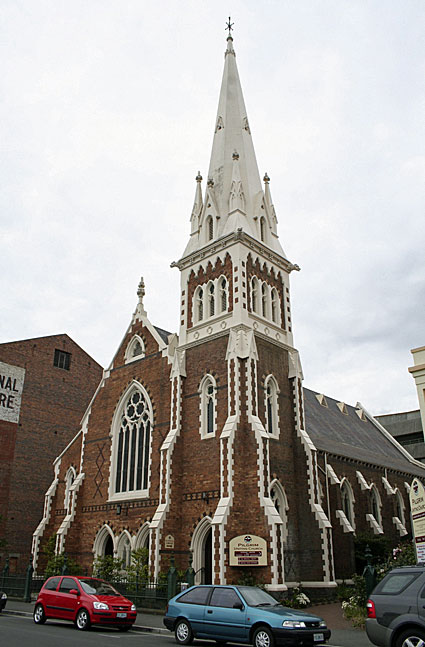
Pilgrim Uniting Church, Launceston: exterior
[photograph by Trevor Bunning (29 April 2011)]
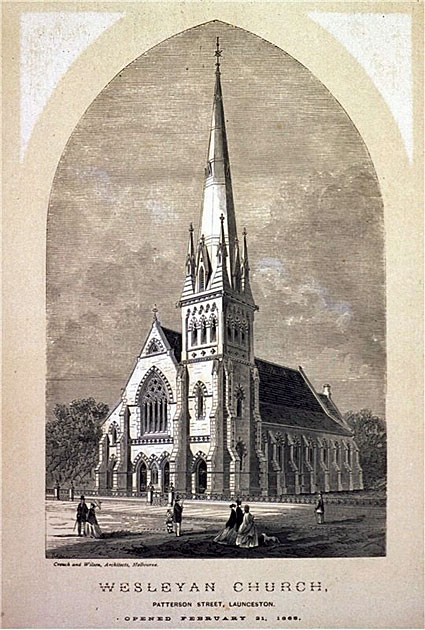
Wesleyan Church, Patterson Street, Launceston: Crouch & Wilson's original design
[photograph by John Maidment from original at church (29 April 2011)]
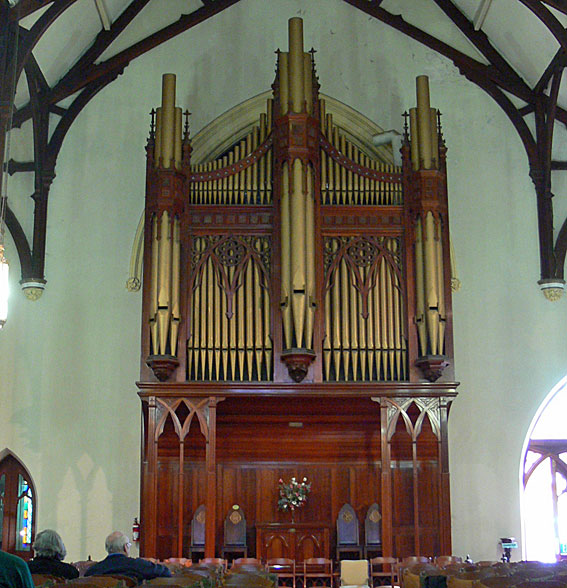
Pilgrim Uniting Church, Launceston: interior from rear
[photograph by John Maidment (29 April 2011)]
This large Decorated Gothic church in polychrome brick with stucco dressings built in 1866-68 was designed by the notable firm of Melbourne architects Crouch & Wilson1 and based upon St Peter's Church, Woolwich, designed by A.W.N. Pugin.2 This firm was responsible for many distinguished church designs of the period including the former Brunswick Street Methodist Church, Fitzroy, Golden Square Methodist Church, Bendigo, the Church of the Immaculate Conception, Hawthorn and Durham Street, Methodist Church, Christchurch, NZ (flattened in the recent earthquake there).3 The exterior is dominated by a large tower and spire, with flanking pinnacles, placed to the right of the main façade, which incorporates a large traceried window.
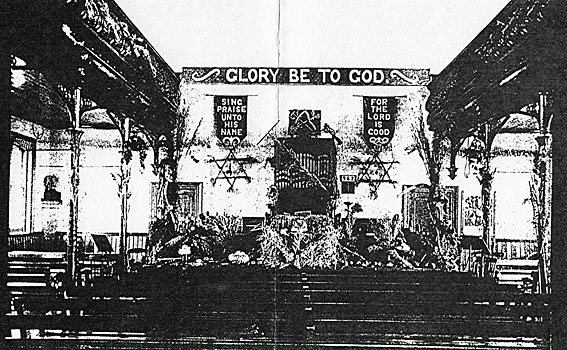
Wesleyan Chapel, Patterson Street, Launceston: interior showing the original organ
[photograph kindly supplied by The Revd Michael Johnson 2002]
The church has had three pipe organs. The earliest known instrument is shown in a very interesting photo of a small organ in the previous Paterson Street Wesleyan Chapel which is now the hall next door; this instrument has not been reliably documented elsewhere. This organ was later sold to Richard Gee, Launceston. Its builder and history are unknown. It was installed after October 1849, when a harmonium was reported in use and before its removal to the present church, opened in 1868.
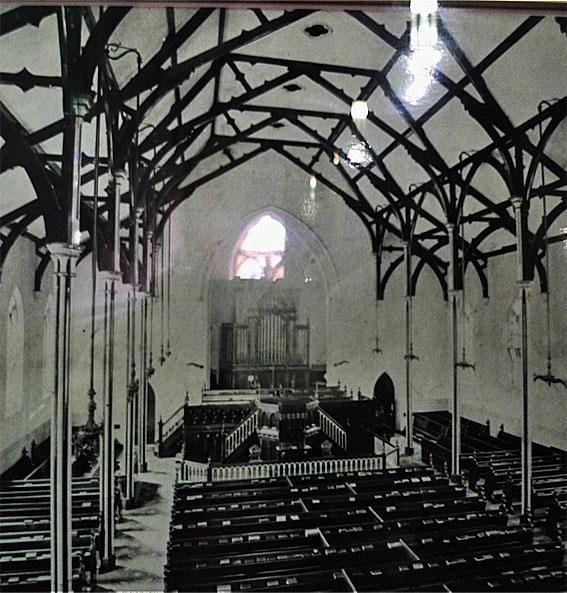
Wesleyan Church, Patterson Street, Launceston: interior showing the Fincham organ of 1880
[from original photograph at church kindly supplied by Trevor Bunning (29 April 2011)]
The second organ, built in 1880 by George Fincham, was later moved to Trinity Uniting Church, Margaret Street, Launceston, where it has since been rebuilt and enlarged.4
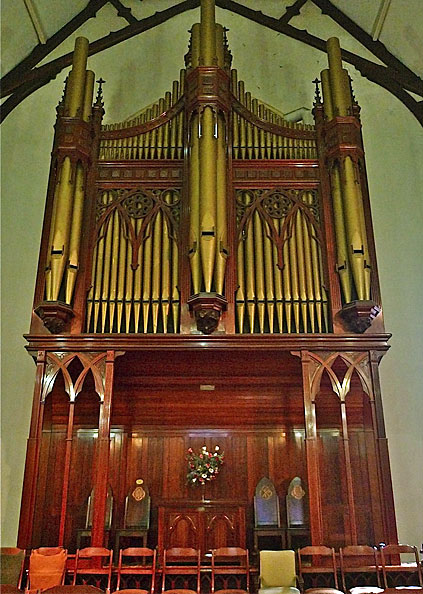
Pilgrim Uniting Church, Launceston: Dodd organ case
[photograph by Trevor Bunning (29 April 2011)]
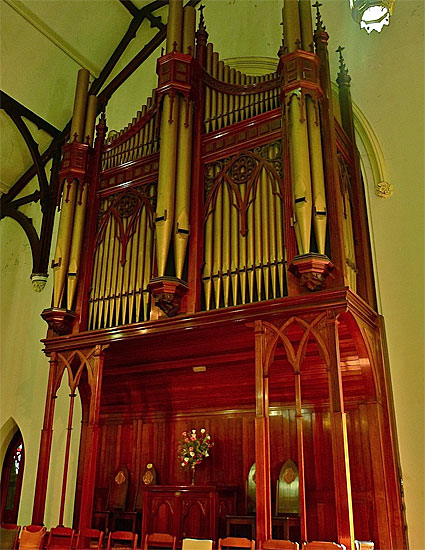
Pilgrim Uniting Church, Launceston: Dodd organ showing returns of case
[photograph by Trevor Bunning (29 April 2011)]
The present organ in Pilgrim Church was built by the Adelaide organbuilder Josiah Eustace Dodd (1856-1952) and is the largest of his instruments to remain tonally intact. It was built in two stages. The initial agreement with Dodd was made on 4 January 1910 with completion promised by 24 December of the same year. The Great Mixture, Swell Contra Cornopean (12 pipes), Choir Organ and the Pedal Subbass and Trombone (12 pipes) were initially prepared for, but Dodd quoted on 19 November 1910 for the completion of the instrument. The Choir Diapason was not initially intended, but the Dodd books record that "The Boss has since decided to PREPARE the MELODIC DIAPASON 8ft."5 The cost was £1,687/11/- .6 The instrument, completed in 1912, was built with Dodd's latest form of tubular-pneumatic action, and incorporated a console imported from Germany, with elaborate registration accessories, including compound automatic pistons and sforzato pedal movements.7
The following contemporary report described the instrument in some detail:
The installing of the new organ at the Patterson-street Methodist Church was completed this week, and tonight the opening ceremony took place, when a recital was given. The organ has been pronounced to be the best in the city and the beautiful tone gave considerable pleasure to the crowded congregation tonight.
The front case of the organ is of striking and imposing design, being Gothic in style. It is of Tasmanian blackwood, French polished, giving it a very fine appearance. The instrument contains three manuals and independent pedal clavier, the great organ comprising 10 stops, swell organ 12 stops, choir organ 8 stops, and pedal organ 9 stops, making in all 38 speaking stops, 11 couplers or mechanical stops, and 38 pneumatic accessories. The front case consists of three towers and two flats of pipes, in addition to two return flats, built on an elaborate fascia corbelled and canopied structure. The front pipes are silvered, the lips being gilded and outlined with a band of colour. The case harmonises admirably with the general architectural features of the building, is exceedingly impressive in appearance and a handsome exposition of modern organ case designing and construction. The action is constructed on the tubular pneumatic principle throughout, and although the tubes conveying the wind from the console or keyboards are over 40ft. Long, the attack and repetition is perfect throughout the compass. The draw-stop action, which is constructed on the stopkey system, was introduced by Mr. J. E. Dodd in the large three-manual organ at the Elder-hall, Adelaide University. The open diapason metal kept in the pedal organ, is the largest in the State. Special mention must also be made of the double diapason, phonon diapason, melodic diapason in the great organ compass, and the vox humana in the swell organ compass. A novel and very ingenious contrivance is the melody coupler. This stop is so constructed that the highest note played on any manual is reinforced or accentuated on the stops of the other manuals, making the air or melody predominate over the accompaniment, the effect being similar to an instrumental solo with an organ accompaniment. The effect is striking. The balanced sforzato pedal is also an item which calls for special mention. In appearance it is like the metal sole of a boot placed to the right of the crescendo pedal. Upon the toe of the pedal being depressed the softest stop of the organ is brought into action. As the tor further advances the stops are brought on in rotation, including all the couplers and pedals, until grand organ is reached. Then, by depressing the heel, the stops are automatically shut off, until only the softest and most delicate are in use. The ensemble of the instrument is very fine, the power being quite surprising, and the balance perfect. A Swanton water engine generates the wind raised at a high pressure into the main reservoir and from which the pneumatics and certain of the heavier stops derive their energy. The wind is conveyed from the main bellows into smaller ones at varied and low pressures to supply the stops according to their peculiar properties and demands. The organ was built by Mr J.E. Dodd, of Adelaide, upon whom it reflects the greatest credit.
The Rev. R. Philp referred to the generosity of the people of the church, and especially the family of the late Hon. Wm. Hart, who had provided the nucleus of the fund. He handed to the Hon. F. W. Grubb and Mr. Jno. Hart, trustees, two gold keys, with which they opened the locks of the organ. The organ was then formally declared open, and a recital was given.8
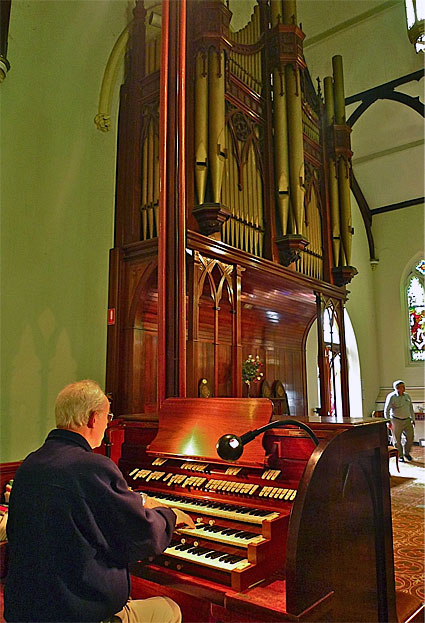
Pilgrim Uniting Church, Launceston: console – Hans Meijer performing
[photograph by Trevor Bunning (29 April 2011)]
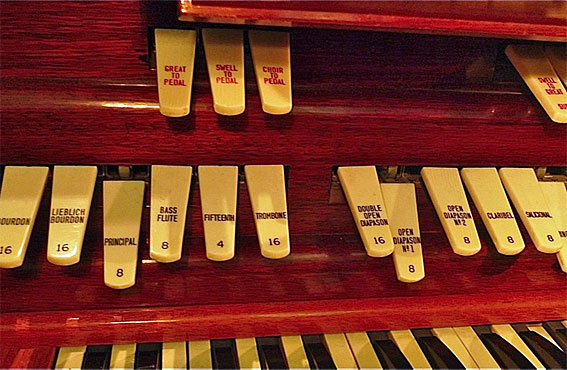
Pilgrim Uniting Church, Launceston: console – detail of stopkeys
[photograph by Trevor Bunning (29 April 2011)]
In 1954 George Fincham & Sons Pty Ltd, of Melbourne, in association with Keith Davis, of Launceston, converted the action to electro-pneumatic and refitted the Dodd console with new stopkeys and keyboards. The original tonal scheme remains unaltered apart from the removal of the Swell Vox Humana and preparation for a Mixture. The instrument is among the finest examples of indigenous organbuilding of the period to survive and comparable with the builder's contemporaneous instrument at St Carthage's Catholic Cathedral, Lismore, NSW, where the tonal scheme has been subsequently altered and original material removed.
GREAT
Double Open Diapason
Open Diapason I
Open Diapason II
Claribel
Salicional
Principal
Harmonic Flute
Fifteenth
Mixture
Tromba
Swell to Great Sub
Swell to Great
Swell to Great Super
Choir to Great Sub
Choir to Great
Choir to Great Super
|
16
8
8
8
8
4
4
2
III
8
|
A
B
|
| |
|
|
SWELL
Lieblich Gedact
Geigen Diapason
Hohlflute
Aeoline
Voix Celeste
Octave
Flauto Traverso
Mixture
Contra Cornopean
Cornopean
Oboe
Tremulant
Sub Octave
Unison Off
Super Octave
|
16
8
8
8
8
4
4
III
16
8
8
|
D
TC
prepared-for – space previously occupied by Vox Humana 8
E
E
|
| |
|
|
CHOIR
Open Diapason
Lieblich Gedact
Viol d'Orchestre
Dulciana
Lieblich Flute
Flautina
Clarinet
Orchestral Oboe
Tremulant
Sub Octave
Super Octave
Swell to Choir
|
8
8
8
8
4
2
8
8
|
(enclosed)
|
| |
|
|
PEDAL
Acoustic Bass
Open Diapason Wood
Open Diapason Metal
Bourdon
Lieblich Bourdon
Principal
Bass Flute
Fifteenth
Trombone
Great to Pedal
Swell to Pedal
Choir to Pedal
|
32
16
16
16
16
8
8
4
16
|
F/G
F
A
G
D
B
G
B
C
|
| |
|
|
Great to Toe Pistons
Swell to Toe Pistons
Compass: 61/30
Electro-pneumatic key and stop action
Balanced electro-pneumatic swell pedals
Detached stopkey console9
In 2018, Wakeley Pipe Organs Pty Ltd, of Bayswater, Vic. overhauled the electro-pneumatic slider machines for the Great Organ, releathered two tremulants and cleaned and regulated the pipework of the Great Organ.10
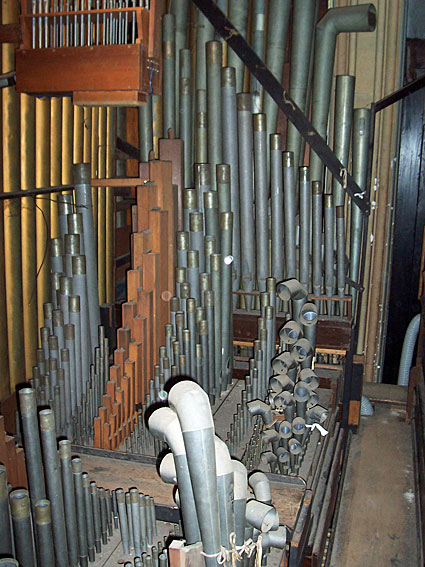
Pilgrim Uniting Church, Launceston: Great Organ pipework
[photograph by Peter Dowde (30 January 2010)]
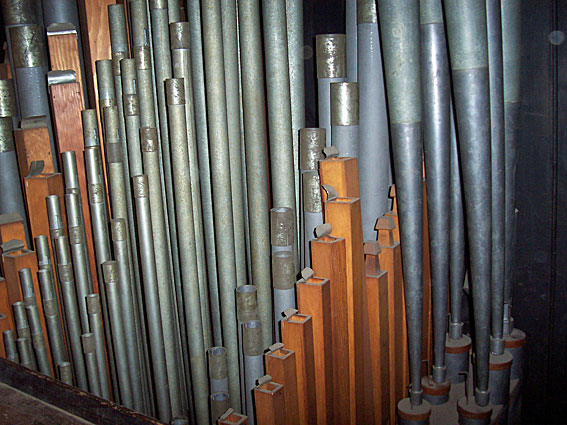
Pilgrim Uniting Church, Launceston: Swell Organ pipework – 16ft Cornopean to the right
[photograph by Peter Dowde (30 January 2010)]
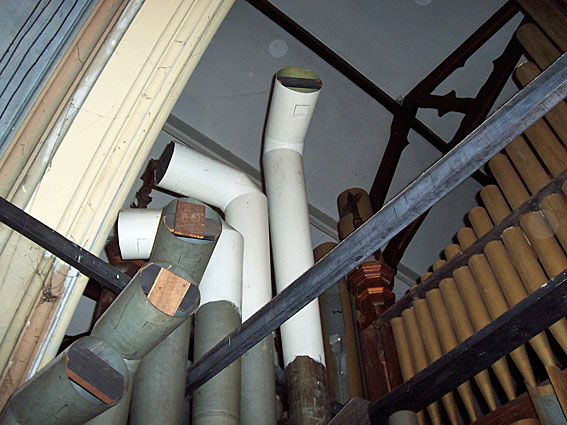
Pilgrim Uniting Church, Launceston: Pedal Trombone 16ft
[photograph by Peter Dowde (30 January 2010)]
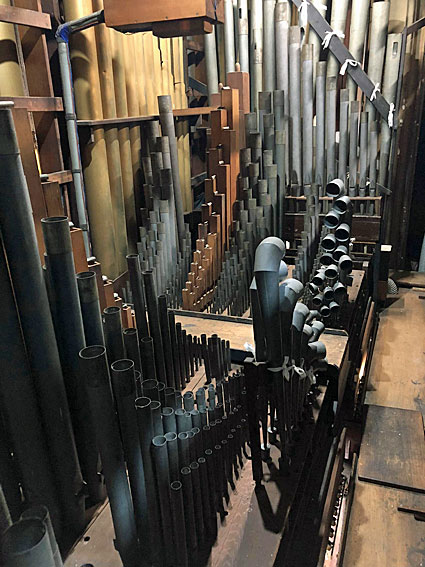
Pilgrim Uniting Church, Launceston: Great pipework after cleaning
[photograph by Jeremy Smith (August 2018)]
1 The heritage of Australia. South Melbourne: Macmillan, 1981, p.7/126
2 Pamphlet issued by church c.1983
3 List compiled by John Maidment
4 Information supplied by Peter Schultz 22 April 2002 to John Maidment; E.N. Matthews, Colonial Organs and Organbuilders (Carlton, Vic.: Melbourne University Press, 1969), p. 200
5 Information from Dodd letter books, transcribed by OHTA
6 Brian Clark & Michael Johnson, Pipe Organs of Tasmania. 3rd ed. Hobart, Tas.: Hobart Organ Society, 2002, see under organ 33
7 Dodd letter books
8 The Mercury, 16 February 1911, p.2
9 Specification noted 1967 John Maidment with additional data supplied by Peter Schultz 22 April 2002
10 Information provided by Graham Horrocks, church treasurer and Jeremy Smith, of Wakeley Pipe Organs












